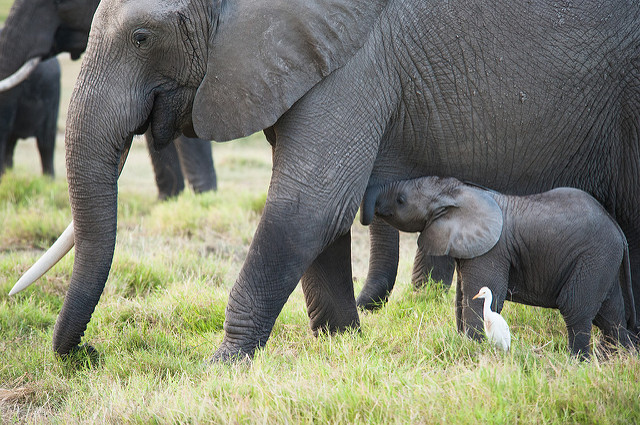新研究指出,最年長、最有智慧的母象持續遭到盜獵,可能對整個熱帶雨林生態造成負面的連鎖反應,因為年長母象扮演「生態系統工程師」的角色,維護雨林重要棲地的完整性。
年長母象是雨林的知識寶典。圖片來源:Jessica Leas(CC BY-NC 2.0)。
我們禁不起失去一頭母象
科學家與國際野生物保護協會、斯德靈大學和安博塞利大象信託(Amboseli Trust for Elephants)共同發出警告,指出年長母象是雨林知識的寶典,但是大象盜獵活動頻繁,常造成年長母象的死亡。
長期研究草原象的科學家,記錄下盜獵和其他人類干擾對草原象行為的深遠影響。
最年長的母象指引和教導晚輩覓食地點、吃哪些食物、如何處理難應付的食物,以及如何躲避危險。年長的象遭到盜獵,不管是公象或母象,都會影響象群的社交行為和生存技巧。少了這些長輩,森林象社交能力和生態系統功能將難以傳承。
科學家指出,由於盜獵活動的關係,草原象的夜間活動越來越頻繁,在保護區外更容易受到驚嚇,常常大批象群擠在一起,使得該處森林因活動象群增加而逐漸劣化。
主要作者、國際野生物保護協會保育學家布勞耶(Thomas Breuer)說:「我們自2013年起注意到森林象減少的危機。和草原象一樣,失去年長母象的後果最為嚴重。」布勞耶和其他共同研究者認為,森林象的遭遇以及對生態系統的影響和草原象一樣。
森林象散播許多植物和樹木的種子,自然地保持著森林的運輸系統和空曠空間,散佈和更新土壤養分,扮演著幫其他動植物維護棲地生態的角色。
大象一家人。圖片來源:Diana Robinson(CC BY-NC-ND 2.0)。
幫大象建資料庫 首選非洲象天堂
1968年,學者開始在坦尚尼亞北部研究大象。四年後,他們在安博塞利國家公園(Amboseli National Park)找到研究大象的理想地點。1972年,安博塞利大象研究計畫開始監控公園內的象群,辨識每一隻個體,紀錄出生、死亡時間和行為。
這是全世界歷史最悠久的野生大象研究,紀錄了近3000隻大象的生活與死亡,現在安博塞利大象研究計畫是研究合作與訓練的樞紐,更是重要的大象基線資料庫。
1979年,非洲約有130萬頭大象,10年後剩下60萬頭。光是肯亞境內,象群就從1973年的13萬頭減少至1989年的2萬頭不到,減少了85%。
由於研究人員駐紮和遊客往來,加上當地遊牧民族馬賽人的支持,安博塞利國家公園的象群是少數相對穩定的野生族群。
沒有盜獵和屠殺活動,安博塞利國家公園象群自1970年代起緩慢增加,是非洲少數象群社會結構未被嚴重破壞的地方,從新生小象到60歲的年長母象都有。
The ongoing poaching of the oldest and wisest female forest elephants could cause cascading harmful effects on the integrity of entire rainforest ecosystems, new research shows. These “ecosystem engineers” maintain the habitats on which many other plant and animal species depend .
Scientists working with the Wildlife Conservation Society, the University of Stirling, and the Amboseli Trust for Elephants warn that the present high levels of “poaching forest elephants will result in a loss of the oldest, wisest matriarchs, who are living libraries of their vast rainforest domain.”
The oldest females guide and teach their young where to go for food and minerals, what to eat, how to process tricky foods, and how to avoid danger. Without these mothers, forest elephant social lives and their understanding of their ecosystem will be lost, the scientists conclude in a new online article in the journal “Conservation Biology.”
“We’ve been aware of the catastrophic decline of forest elephants since 2013,” said WCS conservationist Dr. Thomas Breuer, lead author of the essay. “But, as with savannah elephants, the impacts are greatest when we lose the matriarchs.”
Scientists conducting long-term studies on savannah elephants have documented many, and long-lasting, effects of poaching and other human disruptions on their behavior.
Savannah elephants exposed to poaching become more nocturnal and more skittish outside of the protected areas, where more and more elephants crowd together, say the scientists. The forests there become degraded as many more elephants graze and browse on the foliage.
The loss to poachers of older individuals, both male and female, destabilizes the population socially and robs other elephants of the survival skills of the most experienced members, the scientists conclude.
Breuer and his co-authors say forest elephants are probably experiencing, and causing, the same behavioral and ecological changes in their ecosystems as savannah elephants.
Forest elephants disperse the seeds of many plant and tree species, maintain trail systems and natural forest clearings, and distribute and renew soil nutrients across enormous areas. Their role as ecosystem engineers maintains the habitats on which many other plant and animal species depend.
In 1968, Cynthia Moss began to study elephants in northern Tanzania with Iain Douglas-Hamilton. Four years later, with Harvey Croze, she found ideal conditions for studying elephants in Amboseli National Park.
Since 1972, the Amboseli Elephant Research Project has monitored the Amboseli Park elephants, identifying all the individuals in the population and gathering data on births, deaths and behavior.
Today Moss’s work is the world’s longest-running study of wild elephants, documenting the lives and deaths of almost 3,000 elephants. The Amboseli Elephant Research Project is now a hub for research collaboration and training.
One of the of the longest-studied populations of free-living large mammals in the world, the AERP is a critical source for baseline data on elephants.
In 1979, there were estimated to be 1.3 million elephants in Africa; 10 years later, there were only about 600,000. In Kenya alone, the elephant population dropped from 130,000 in 1973 to less than 20,000 in 1989 – loss of 85 percent.
The elephant population in Amboseli National Park is one of the few that has been able to live relatively undisturbed in natural conditions. This rare situation is due to the presence of researchers and tourists in the park, and the support of the local Maasai people.
In the absence of poaching and culling, the Amboseli elephant population has been increasing slowly since the late 1970s. Amboseli is, therefore, one of the few places in Africa where the elephant age structure has not been drastically skewed and the population spans the whole range from newborn calves to old matriarchs in their 60s.
※ 全文及圖片詳見:ENS






